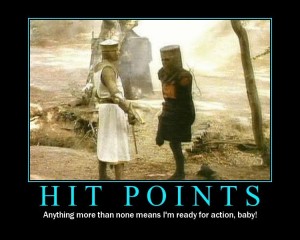![]()
 It was a couple of days before the recent and lovely Hit Points, Our Old Friend article hit the D&D site. I had actually been experimenting in my 30th level D&D tribal campaign with hit points and morale, blending them together like a fine, time-saving… erm… wine? Cheese? Taco?
It was a couple of days before the recent and lovely Hit Points, Our Old Friend article hit the D&D site. I had actually been experimenting in my 30th level D&D tribal campaign with hit points and morale, blending them together like a fine, time-saving… erm… wine? Cheese? Taco?
Whatever! I’m actually a little suprised that Mike Mearls’ definition of hit points in that article didn’t include morale. It includes just about everything else – all good stuff, too. What gives? Morale seems obvious to me. It should be there!
At any rate, treating (D&D 4e’s exhorbitant monster) hit points as part-morale in addition to everything else we know and love them to be was indeed time-saving. Even better, it proved to be an elegant, balanced solution – the types of solutions to clunky or complex RPG elements I love to create and implement. I mean, that’s how I game, and that’s why Leonine Roar exists!
Doesn’t there always seem to be a shortage of perfectly blended storytelling and mechanical components to D&D these days?
And don’t monsters have far too many damn hit points, especially at high levels?
Not a new problem, but how about a new, more elegant solution beyond the typical, boring slashing of hit points and subsequent damage increase “just because?”
Expand the definition of hit points to include morale. Here’s how:
Hit Points = Morale
Concept: Hit points also include morale. When champions, leaders, or a number of monstrous allies are bloodied or defeated (fall, are captured, surrender or flee, etc.) the hit points of the remaining hostile monsters decrease. Their will to fight – their morale – diminishes. Their new hit point totals quantify this change.
Execution: Whenever a solo, elite, or leader (whether a “keyword” leader or simply the leader of a monster group in the familiar sense) is bloodied or defeated, reduce the hit points of all other remaining creatures by 50%. Optionally, as an even faster alternative, expand the trigger to include any standard monster and/or at least half the total number of monsters. Note this effect can occur multiple times in a single battle.
Example of Play
Know those really cool epic battles that wrap up an adventure or even campaign? Loaded with lots of cool monsters and fantastic locations? Monster waves, deadly terrain and stakes so high they literally include the world or even more?
Then you also know they often take hours to run right in D&D 4e! As someone extremely cool and famous once said, “the problem is time,” so let hit points as morale help you save some of that precious time. Speed up the battle using Hit Points = Morale.
Here’s an example of play using Hit Points = Morale:
The party fights through dozens of tiny, winged demonling minions to finally batter the Storm Giant shaman first. The primal heroes beat the lightning and thunder out of the arrogant shaman atop his personal stormcloud, finally bloodying him.
Immediately, the shaman’s best bodyguard, an elite storm giant warrior is rattled by his shaman’s grievous wounds: the party of simple tribesfolk is much mightier than they anticipated and are worthy of their respect in battle.
Finally, the squad of air elementals (standard artillery) nearby are also impressed – they also immediately lose 50% of their current hit points.
A few rounds later, and the storm giant warrior is now badly hurt. The shaman’s will to fight takes another hit, as does all the elementals’.
And then, with a maniacal roar, your barbarian finally cleaves through the critically wounded storm giant shaman, sending his corpse to the snowy earth far, far below. The storm giant bodyguard takes a long step back, and the remaining few elementals flash concerned looks at eachother. (Slash all their hit points again by 50%!)
See? Easy to use, and easy to track. You apply the change only when the “big names” get hurt or fall, and then it’s the simple math of 50% less hit points to each non-minion creature in the fight.
You’ve not only sped up combat by reducing hit points, but you’ve done it by weaving in realistic shifts in morale based on near or actual monster casualties. Brilliant! After the battle, the players will thank you (and you’ll thank yourself!) for using such an elegant solution and saving so much time – while still keeping the action, pace, and danger high.
Slog and grind? Gone! And for good, believable, flavorful reasons right in the thick of battle.
Will Yourself to Fight!
Wouldn’t you trade the back half of combat’s grind or slog for more action and adventure?
Go forth and experiment with this simple hit points = morale system and come back and tell me how it worked in your games!
Image Source
Good article. I like the idea of using that not as an out and out subtraction of hit points, but as a guide to show when monsters should flee or surrender. It can also simulate really well how a few monsters here and there will break, which may cause a group to break and then it becomes a full rout as everyone runs away. I like it.
Quirky DM recently posted..Go Vote for Someone .. Anyone … at Site of the Year
Quirky, good call as far as also using this different hit point reducing points as guides for true morale checks, surrender, capture and so on. An even less gamey solution, I like it! (Still works wonders on the gigantic epic tier hit point numbers though, I promise!)